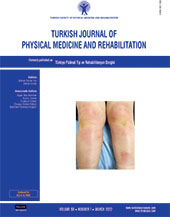The effects of spasticity on glucose metabolism and soft tissue body composition in patients with spinal cord injury
2 Department of Physical Medicine and Rehabilitation, Yeditepe University Hospital, Istanbul, Turkey
3 Department of Physical Medicine and Rehabilitation, Erenköy Physical Medicine and Rehabilitation Hospital, Istanbul, Turkey
4 Department of Physical Medicine and Rehabilitation, University of Health Science, Haydarpaşa Numune Training and Research Hospital, Istanbul, Turkey DOI : 10.5606/tftrd.2022.6310 Objectives: The aim of this study was to assess the effects of spasticity on glucose metabolism and percentage of fat-free mass (FFM%) in patients with spinal cord injury (SCI).
Patients and methods: A total of 33 patients (22 males, 11 females; mean age: 38.6±12.5 years; range, 20 to 64 years) with SCI defined by the American Spinal Injury Association Impairment Scale Grades A to D were included between September 2014 and May 2018. We assessed spasticity with the Modified Ashworth Scale (MAS) and evaluated spasms with the Penn Spasm Frequency Scale (PSFS). We assessed the glucose metabolism by calculating the Matsuda and HOMA-IR index, and measured FFM% by dual-energy X-ray absorptiometry.
Results: Fourteen patients had motor complete, and 19 had motor incomplete SCI. The neurological injury levels of the patients were C4-T12. There was a positive correlation between hip adductor muscle MAS and trunk, android, and gynoid FFM% and between hip extensor muscle MAS and android FFM% in patients with motor complete SCI. Hip extensor and knee flexor muscle MAS showed a negative correlation with the HOMA-IR. Hip adductor and extensor muscle MAS, as well as knee flexor and extensor muscle MAS, had a positive correlation with the Matsuda index in these patients. There was a positive correlation between knee extensor muscle MAS and gynoid FFM% and between PSFS and arms, trunk, gynoid, and total FFM% in patients with motor incomplete SCI. There was a negative correlation between hip adductor and extensor muscle MAS, PSFS, and level of fasting glucose in these patients.
Conclusion: This study supports the notion that spasticity has positive effects on the FFM% and glucose metabolism in patients with motor complete and incomplete SCI.
Keywords : Body composition, glucose, spasticity, spinal cord injury

















